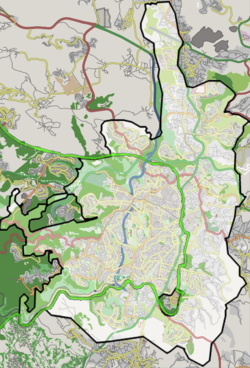Deir es-Sultan
 | |
| Monastery information | |
|---|---|
| Other names | Deir Al-Sultan |
| Established | 335[citation needed] |
| Dedicated to | Archangel Michael & the Four Incorporeal Creatures[citation needed] |
| Diocese | Disputed between the Ethiopian Orthodox Tewahedo Church's Archbishopric of Jerusalem and the Coptic Orthodox Archdiocese of Jerusalem |
| People | |
| Founder(s) | Constantine the Great[citation needed] |
| Site | |
| Location | Old City (Jerusalem) |
| Coordinates | 31°46′42″N 35°13′47″E / 31.778444°N 35.22975°E |
| Public access | Yes |
Deir es-Sultan, literally the Monastery of the Sultan (Arabic: دير السلطان, romanized: Deir al-Sultan), is a monastery located on the roof of the Chapel of Saint Helena, which is part of the Church of the Holy Sepulchre in Jerusalem's Old City. The Status Quo, a 250-year old understanding between religious communities, applies to the site.[1][2]
History
[edit]Deir es-Sultan is one of several holy sites in the area which are contested by various Christian denominations.[3] The monastery is located on the roof of the Helena Chapel, an underground chapel that is part of the Church of the Holy Sepulchre complex, and has an entrance leading down to the Parvis (the Church courtyard). The monastery covers an area of 1,800 square meters.[citation needed]
Ownership is a subject of dispute between the Ethiopian Orthodox Tewahedo Church and the Coptic Orthodox Church of Alexandria.[4][5][6]
According to the Coptic Church, Umayyad caliph Abd al-Malik ibn Marwan granted the church to the Copts, to be named as "Deir el-Malak" (Angel Monastery), which was later confirmed by Saladin, after it was confiscated by the Crusaders, to be renamed as "Deir es-Sultan".[7] Later on, the Ethiopian monks were hosted by the Copts in 1654, as their churches in Jerusalem were acquired by the Greek and Armenian Churches due to the inability to pay taxes.[7]
The Ottoman Sultan Abdülhamid II granted the Ethiopians the right to set up a large tent on the roof of the Holy Sepulcher to celebrate Easter.[8]
During the Easter Vigil in the Church of the Holy Sepulcher on April 25, 1970, the Israeli government sent military forces to change the locks of the monastery to enable the Ethiopian monks to take control of it. Afterwards, the Israeli Supreme Court unanimously approved the restoration of the monastery to the Copts on March 16, 1971, yet the government refused to implement the Supreme Court ruling.[7]
In October 2018, a Coptic priest was arrested following protests against the restoration efforts of the monastery without the Coptic Church's consent.[9] In April 2021, "light clashes" erupted between Egyptian and Ethiopian monks, as the latter set a tent and raised the Ethiopian flag inside the monastery.[10] The same incident was repeated a year later on 18 April 2022.[11] In 2022, the same type of event provoked the Coptic monks to paint the flag of Egypt on the main door leading to the monastery, adjacent to the entrance to the Coptic Patriarchate of Jerusalem.[12]
Gallery
[edit]-
Easter 1941
See also
[edit]- Kidane Mehret Church, Jerusalem - the Ethiopian church and monastery in the New City
References
[edit]- ^ UN Conciliation Commission (1949). United Nations Conciliation Commission for Palestine Working Paper on the Holy Places.
- ^ Cust, L. G. A. (1929). The Status Quo in the Holy Places. H.M.S.O. for the High Commissioner of the Government of Palestine.
- ^ Johan D. Van Der Vyver; John J. Witte (1996). Religious Human Rights in Global Perspective: Legal Perspectives. Martinus Nijhoff Publishers. pp. 380–. ISBN 978-90-411-0177-8. Retrieved 20 April 2013.
- ^ Robin Twite, "Africa in Jerusalem - The Ethiopian Church" in The Israel Review of Arts and Letters, 1996/102
- ^ Davies, "Unholy row threatens Holy Sepulchre" (BBC)
- ^ Jonathan Lis, "Monastery Atop Church of Holy Sepulchre in Danger of Collapse" (HaAretz)
- ^ a b c "Deir Es-Sultan Monastery's mediation by Greek Church unsuccessful: Egypt Pope". egyptindependent.com. 6 December 2018. Retrieved 10 May 2022.
- ^ "Ethiopiens, les exclus du Saint-Sépulcre". La Croix (in French). 4 April 2010.
- ^ "غضب قبطي بعد "اعتداء اسرائيلي" على دير السلطان بالقدس" [Coptic anger after an "Israeli attack" on Deir Al-Sultan in Jerusalem]. Sky News Arabia (in Arabic). 24 October 2018.
- ^ "Egyptian, Ethiopian churches clash over Deir al-Sultan in Jerusalem". Al-Monitor. 8 May 2021.
- ^ "Egyptian, Ethiopian monks clash in Jerusalem". Arabnews. 20 April 2022.
- ^ "Deir Al-Sultan: Ethiopians, Egyptians clash in the Holy land". Borkena. 22 April 2022.
External links
[edit] Media related to Deir es-Sultan at Wikimedia Commons
Media related to Deir es-Sultan at Wikimedia Commons
- Oriental Orthodox monasteries in Jerusalem
- Coptic Orthodox Church in Asia
- Egyptian diaspora in the Middle East
- Status quo holy places
- 4th-century establishments in the Byzantine Empire
- Ethiopian Orthodox Tewahedo churches in Jerusalem
- Coptic Orthodox Churches in Jerusalem
- Christian Quarter
- Church of the Holy Sepulchre





